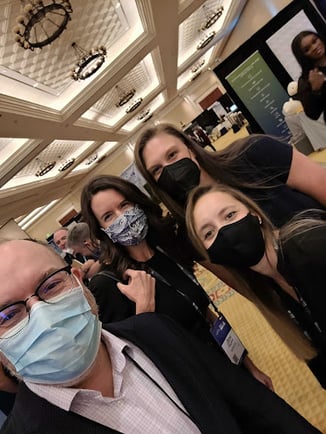Providing Recruiting Solutions at PrismHR LIVE

The HiringThing team left PrismHR Live energized by the connections we made and the insights we gained. We’re grateful to have spent meaningful time with valued HiringThing partners and clients. Now that we’re home, we want to share what we learned:
The world of work has changed forever, and technology is enabling small and medium-sized businesses (SMBs) to positively impact their employees, customers, and organizations.
It’s no surprise that recruiting was a strong theme throughout the conference. Johnny C. Taylor, Jr., President & CEO, The Society for Human Resource Management (SHRM), explained that financial capital is obtainable. Still, companies can’t get access to the human capital they need to grow.
“CEOs are staying up at night worried about talent acquisition” –Johnny C. Taylor, Jr., President & CEO of SHRM.

Honestly, the underlying theme was bleak: businesses are struggling to hire, but there is good news—HR service providers, including PEOs, ASOs, and HCMs, are answering the cries for help.
The HiringThing team takes on PrismHR Live!
Pictured L-R: CEO & Founder Joshua Siler, Director of Client Success Noël Phillips, Director of Marketing Joanna Hartvickson, and Business Development Manager Allie DeCaro.
The New World of HR
Tim Pratte, SVP of Diversified Services at PrismHR, kicked off the event by talking about the atmosphere in the HR space today. “The world and the workplace have changed,” he recounted. He shared how competition is increasing, modern technology moves fast, HR and the new workplace are top of mind, and HR is growing in strategic importance. Pratte made valuable points we’ve found data to back up:
- Competition is increasing: A recent Harris Poll survey found that 82% of companies expect to face hiring challenges in the upcoming year, citing how the current labor market talent shortage has increased competition in the job market. 1 in 4 people quit (not got laid off or fired, but quit) their jobs this year—we throw around the word “unprecedented” a lot recently, but these hiring shifts indeed are unprecedented and will make the future of hiring more competitive than it’s possibly ever been.
- Modern tech is ubiquitous and moves fast: Think about how much of the day you spend utilizing some sort of technology. Probably most of it! And think back (if you’re as old as us) just fifteen or so years ago to the mid-aughts: mailing in resumes and cover letters was the norm then! Now? 98% of Fortune 500 companies utilize an applicant tracking system (ATS) to help them recruit and hire. What’s innovative today can be outdated tomorrow.
- HR and the new workplace is top of mind: Organizations realize that investing in HR saves time and money, enables productive remote work, shows employees they care, improves hiring and retention, and can promote employee well-being and personal development, which are two areas growing in importance for today’s workforce.
- HR is increasing in strategic importance: “If HR didn’t already influence the C-Suite before the pandemic, it does now,” wrote Tam Harbert in a September 2021 piece for SHRM titled “The Pandemic Has Expanded the Role of HR.” Because organizations realize how vital HR is to navigate this new era of work, they’re willing to invest more time and resources into it. HR is moving from a nice-to-have to a leading role in savvy organizations.
What does this mean for those of us in the HR world? We need to be flexible, adaptable, strategic and adopt a growth mindset to meet these workplace changes head-on. We’re also more in demand than ever, which makes it even more critical that we’re providing quality, meaningful, people-first solutions for the clients we serve.
Talent Migration: The New Recruiting Reality
Our own Joshua Siler, CEO & Founder of HiringThing, shared his expertise with the PrismHR Live attendees in a presentation titled Talent Migration: The New Recruiting Reality. Siler examined the state of today’s labor market, why so many individuals aren’t actively looking for work, how this talent shortage affects SMBs, and most importantly, shared recruiting strategies organizations can use to stay ahead of the massive changes we’re not yet through. His suggestions include:
- Providing scheduling flexibility: Employers can no longer offer unpredictable schedules to workers. Many great employees feel locked out because of childcare, school, and other considerations. Employees need to work with their employers to ensure scheduling is conducive to their lives, and if unpredictable schedules are unavoidable, salaries should reflect that. Otherwise, employers risk great employees walking away.
- Consider remote workers: Remote work has proven to work during the pandemic, and 65% of workers actively want to be remote. With the competition in staffing, remote work also gives employers a much broader potential employee base, as long as they aren’t restricted to a driving distance.
- Update wages to market regularly: The current zeitgeist is that workers should regularly move jobs if they want fair pay, which means that organizations that don’t update wages risk losing current employees and future applicants. Case in point? There’s a now-classic study on fast food restaurants along the New Jersey/Pennsylvania state line. When New Jersey increased their minimum wage, applicants for restaurants on the New Jersey side of the line increased dramatically.
- Allocate resources to recruiting: The current state of the labor market means it’s not enough to post a job and hope for the best. Investing in job advertising and recruiting helps give you a leg over competitors who don’t. It is proven to save organizations time and money and increase the quality of hires—78.3% of new ATS users say usage improved the quality of their new hires.
- Nurture your best employees: Employers need to change the way they view the employer-employee relationship: your employee isn’t lucky to have a job—you’re lucky to have the employee. Recruiting, onboarding, and training costs can be avoided by ensuring the team feels satisfied and valued at their current role. Additionally, nurturing your best candidates and then promoting them internally keeps company morale high (it shows other employees what they can achieve if they do good work).
- Move fast on great hires: The best candidates likely have several offers lined up during today’s job hunts. The application to interview to hire timeline must be expedited to remain competitive. If you regularly wait weeks after applications to make decisions, the best candidates are going elsewhere. Not for nothing, but stats show that organizations using an ATS see quicker hiring times.
A Profession That Helps People
We repeatedly heard at PrismHR Live that if you want to be in a profession that matters, this is your time and place. The pandemic and ensuing work changes have underscored that organizations are not possible without the people that power them, and HR is the business of people, starting with recruiting.
“Talent Acquisition is the most important thing we do,” said Taylor, and helping others recruit and hire is what matters to us here at HiringThing.
About HiringThing
HiringThing is a modern recruiting platform as a service that creates seamless hiring experiences. Our private label applicant tracking system and open API enable technology and service providers to embed hiring capabilities from sourcing to onboarding. Approachable and adaptable, the platform empowers anyone, anywhere, to hire their dream team.



